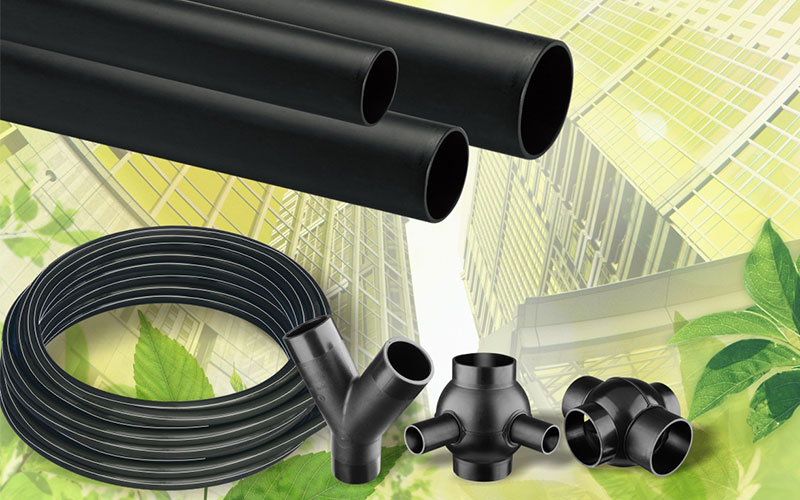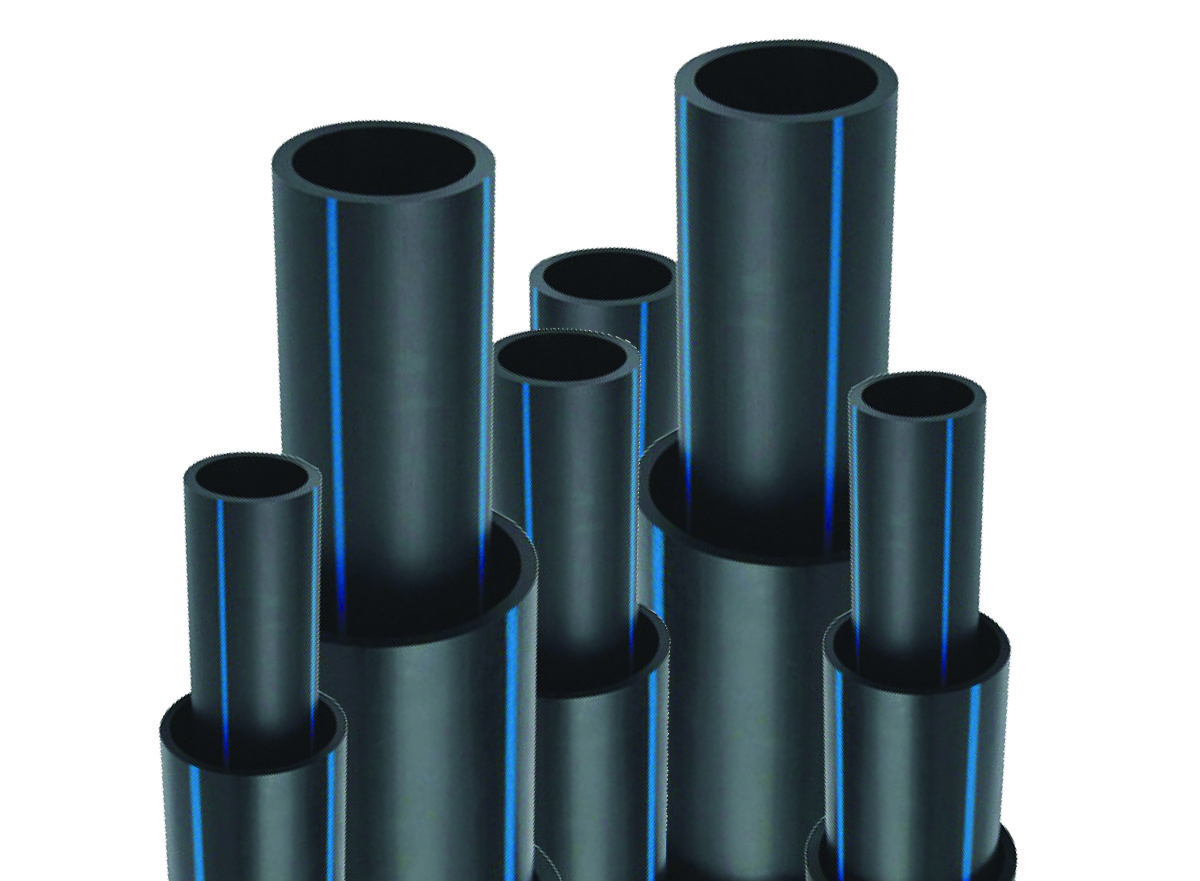The Innovation of American Plastics HDPE Pipe Manufacturing: What You Need to Know
Wiki Article
Explore the Manufacturing Process Behind High-Quality HDPE Pipeline and Its Applications
The production process of high-grade HDPE pipes is complex and systematic. It begins with the selection of basic materials that enhance performance. Following this, ethylene undergoes polymerization to form material, which is after that formed through extrusion. Quality control is extremely important, guaranteeing that the last item meets strict standards. The journey of HDPE pipes doesn't end with production. Their applications across different markets expose a broader value worth examining.Understanding HDPE: Features and Advantages

High-density polyethylene (HDPE) is a versatile thermoplastic understood for its sturdiness and resistance to different environmental elements. This material exhibits superb tensile stamina, making it ideal for requiring applications. Its low-density framework adds to a lightweight item, assisting in ease of handling and installation. HDPE additionally showcases remarkable resistance to chemicals, which reduces degradation when exposed to rough substances.
The material's low moisture absorption further enhances its longevity, making it excellent for use in pipelines and tank. Furthermore, HDPE is resistant to ultraviolet (UV) radiation, making certain that items keep their integrity even when revealed to sunlight. In addition, its flexibility enables the development of intricate forms without endangering toughness. The environment-friendly nature of HDPE, commonly derived from recycled materials, contributes to its appeal, promoting sustainable practices in manufacturing. Generally, these residential or commercial properties and benefits make HDPE a recommended selection for various commercial and customer applications.
Resources Choice for HDPE Manufacturing
The choice of resources for HDPE production is important to confirm the last item fulfills the wanted specifications and top quality requirements. High-density polyethylene (HDPE) is largely created from polymerized ethylene, stemmed from nonrenewable fuel sources such as all-natural gas or petroleum. The top quality of these feedstocks substantially affects the mechanical and thermal properties of the final HDPE.Additives additionally play a considerable function in enhancing HDPE's performance, consisting of antioxidants, UV stabilizers, and colorants, which enhance resilience and resistance to environmental elements. The choice process have to take into consideration not only the chemical make-up of the raw products however additionally their processing features to assure effective production.
The sourcing of raw materials need to prioritize sustainability and compliance with environmental regulations, as accountable practices are critical in today's market. Ultimately, mindful raw material option lays the foundation for creating top notch HDPE pipelines ideal for diverse applications.
The Extrusion Process: Forming HDPE Pipe
The extrusion procedure plays a crucial role in shaping HDPE pipes, beginning with thorough material prep work methods that ensure perfect circulation and uniformity. Just as important is the style of the die, which straight affects the last measurements and surface area top quality of the pipe. Together, these elements add considerably to the performance and top quality of HDPE pipe production.Product Prep Work Techniques
Efficient production of HDPE pipelines begins with meticulous product prep work methods, especially the extrusion process. Throughout this stage, high-density polyethylene resin is very first dried out to eliminate wetness, ensuring perfect flow qualities. The resin is after that fed into the extruder, where it undergoes home heating and melting, transforming right into a thick state. This heating process is very carefully regulated to keep the material's integrity and efficiency. The molten HDPE is required through a die, forming it right into a continual pipeline form. Appropriate temperature level management throughout extrusion is essential, as it straight impacts the material's homes and the end product top quality. As soon as formed, the HDPE pipeline is cooled down and reduced to defined lengths, prepared for subsequent handling and applications.Die Design Relevance
Accuracy in die style plays an essential role in the extrusion process of HDPE pipelines. The die functions as the final shaping device, straight affecting the pipe's measurements, wall surface density, and surface area finish. A well-designed die warranties uniform material circulation, minimizing defects such as irregularities and vulnerable points. The geometry of the die should be maximized to suit the specific buildings of HDPE, including its thickness and thermal behavior throughout extrusion. Additionally, the cooling price of the material as it goes through the die can markedly influence the pipeline's architectural honesty. As a result, investing in sophisticated die technology is vital for manufacturers aiming to create top notch HDPE pipelines that meet sector criteria and customer assumptions.Quality Control Steps in HDPE Manufacturing
Various variables influence the quality of HDPE pipe manufacturing, effective quality control procedures are essential to guarantee consistency and dependability in the final item (hdpe pipe suppliers Midland TX). Secret quality assurance methods include rigorous material evaluation, verifying that the raw polyethylene satisfies recognized requirements for purity and thickness. Throughout the extrusion process, criteria such as temperature, pressure, and cooling time are very closely monitored to preserve dimensional precision and architectural stabilityIn enhancement, post-production testing is necessary; makers commonly conduct hydrostatic tests to examine the pipe's stamina and resistance to pressure. Aesthetic assessments for surface area defects additionally enhance high quality guarantee. Accreditation from relevant criteria companies, like ASTM or ISO, supplies an extra layer of visit here reliability. By applying these comprehensive quality assurance measures, producers can decrease defects, enhance performance, and make sure that the HDPE pipes fulfill the certain requirements of different applications, ultimately causing client satisfaction and count on in the product.
Applications of HDPE Pipe Across Industries
HDPE pipes are made use of throughout numerous sectors because of their durability and adaptability. In water circulation systems, they guarantee effective distribution, while in wastewater monitoring, they offer trusted solutions for waste transport. Additionally, agricultural watering networks take advantage of HDPE's resistance to deterioration and versatility, making it an excellent option for contemporary farming techniques.
Water Circulation Equipments
A significant number of markets count on high-density polyethylene (HDPE) pipes for reliable water circulation systems. Recognized for their resilience and resistance to deterioration, HDPE pipes are commonly made use of in municipal supply of water networks, agricultural watering, and commercial applications. Their lightweight nature assists in easy handling and installment, decreasing labor costs and time. Furthermore, HDPE pipes can accommodate various pressure degrees, making them suitable for both reduced and high-pressure systems. American Plastics HDPE Pipe Manufacturing. The versatility of the product enables smooth assimilation right into existing infrastructure, lessening the requirement for considerable excavation. HDPE's resistance to chemical seeping guarantees that the water provided continues to be risk-free and tidy, making it a suitable choice for preserving the high quality of drinkable water across numerous industries.Wastewater Management Solutions
Effective water distribution systems likewise lead the way for innovative wastewater administration solutions, where high-density polyethylene (HDPE) pipes play a considerable function. Popular for their resilience and resistance to corrosion, HDPE pipes are suitable for delivering wastewater in numerous setups. Their adaptability permits easy installation in complicated environments, lessening the need for substantial excavation. In addition, HDPE's smooth interior surface reduces friction, improving circulation official website rates and efficiency. These pipes are additionally immune to chemical leaching, making sure that impurities do not jeopardize the surrounding setting. Industries, municipalities, and treatment centers progressively depend on HDPE pipes for their integrity and durability, making them a favored option for modern wastewater monitoring systems. This adaptability highlights the crucial value of HDPE pipelines across countless applications.Agricultural Watering Networks
Agricultural irrigation networks benefit considerably from making use of high-density polyethylene (HDPE) pipes, which give reliable and dependable water delivery to crops. HDPE pipes are light-weight, making them very easy to transfer and install, while their adaptability enables for different arrangements in diverse surfaces. These pipes demonstrate exceptional resistance to corrosion, chemicals, and UV radiation, guaranteeing resilience in severe agricultural settings. Furthermore, their smooth interior surface area reduces friction loss, maximizing water flow and minimizing power prices connected with pumping. The long life of HDPE pipes, typically surpassing 50 years, adds to reduce upkeep and substitute expenditures. Farmers progressively depend on HDPE pipelines to boost irrigation performance and promote lasting agricultural methods, ultimately leading to improved crop yields and source preservation.
Future Trends in HDPE Pipe Innovation
As the need for lasting and reliable infrastructure expands, innovations in HDPE pipe innovation are poised to transform various markets. Arising trends include the assimilation of smart modern technologies, such as sensors and IoT abilities, which assist in real-time tracking of pipeline conditions, decreasing maintenance costs and protecting against leakages. In addition, the advancement of advanced production methods, such as 3D printing, is allowing the manufacturing of complicated, customized pipe designs that provide to details project needs.Furthermore, the concentrate on recycling and round economy techniques is driving the advancement of HDPE pipelines made from recycled materials, boosting sustainability. Boosted jointing techniques, such as electro-fusion and mechanical fittings, are additionally boosting installation performance and reliability. Lastly, the growing emphasis on environmental regulations is pushing producers to embrace greener manufacturing processes, making certain that HDPE pipelines not only fulfill industry requirements however also promote an even more sustainable future for facilities advancement.
Often Asked Concerns
Exactly How Does HDPE Contrast to Various Other Plastic Materials?
HDPE outmatches lots of other plastic materials pertaining to sturdiness, chemical resistance, and versatility. Its low thickness and high tensile strength make it ideal for numerous applications, typically exceeding choices in both efficiency and long life.What Are the Environmental Effects of HDPE Manufacturing?
The ecological explanation impacts of HDPE manufacturing include greenhouse gas emissions, energy intake, and possible contamination from manufacturing processes. Additionally, improper disposal can result in dirt and water contamination, elevating problems about long-term environmental effects.Can HDPE Water Lines Be Recycled?
Yes, HDPE pipes can be recycled. Numerous centers approve used HDPE for processing, changing it into brand-new items. This reusing adds to sustainability initiatives, decreasing plastic waste while saving sources and power in the production cycle.What Is the Lifespan of HDPE Piping?

Exactly How Do Temperature Variations Affect HDPE Pipeline Performance?
Temperature variants greatly affect HDPE pipe performance, impacting flexibility and strength. Heats can cause softening, while reduced temperature levels may trigger brittleness, eventually affecting the pipeline's sturdiness and suitability for numerous applications in diverse environments.Report this wiki page